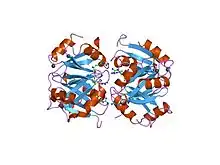| Arginine repressor, C-terminal domain | |||||||||
|---|---|---|---|---|---|---|---|---|---|
 c-terminal domain of escherichia coli arginine repressor/ l-arginine complex; pb derivative | |||||||||
| Identifiers | |||||||||
| Symbol | Arg_repressor_C | ||||||||
| Pfam | PF02863 | ||||||||
| InterPro | IPR020899 | ||||||||
| SCOP2 | 1aoy / SCOPe / SUPFAM | ||||||||
| |||||||||
| Arginine repressor, DNA binding domain | |||||||||
|---|---|---|---|---|---|---|---|---|---|
| Identifiers | |||||||||
| Symbol | Arg_repressor | ||||||||
| Pfam | PF01316 | ||||||||
| SCOP2 | 1aoy / SCOPe / SUPFAM | ||||||||
| |||||||||
In molecular biology, the arginine repressor (ArgR) is a repressor of prokaryotic arginine deiminase pathways.
The arginine dihydrolase (AD) pathway is found in many prokaryotes and some eukaryotes, an example of the latter being Giardia lamblia (Giardia intestinalis).[1] The three-enzyme anaerobic pathway breaks down L-arginine to form 1 mol of ATP, carbon dioxide and ammonia. In some bacteria, the first enzyme, arginine deiminase, can account for up to 10% of total cell protein.[1]
Most prokaryotic arginine deiminase pathways are under the control of a repressor gene, termed ArgR.[2] This is a negative regulator, and will only release the arginine deiminase operon for expression in the presence of arginine.[3] The crystal structure of apo-ArgR from Bacillus stearothermophilus has been determined to 2.5A by means of X-ray crystallography.[4] The protein exists as a hexamer of identical subunits, and is shown to have six DNA-binding domains, clustered around a central oligomeric core when bound to arginine. It predominantly interacts with A.T residues in ARG boxes. This hexameric protein binds DNA at its N terminus to repress arginine biosynthesis or activate arginine catabolism. Some species have several ArgR paralogs. In a neighbour-joining tree, some of these paralogous sequences show long branches and differ significantly from the well-conserved C-terminal region.
References
- 1 2 Brown DM, Upcroft JA, Edwards MR, Upcroft P (January 1998). "Anaerobic bacterial metabolism in the ancient eukaryote Giardia duodenalis". Int. J. Parasitol. 28 (1): 149–64. doi:10.1016/S0020-7519(97)00172-0. PMID 9504342.
- ↑ Lu CD, Houghton JE, Abdelal AT (May 1992). "Characterization of the arginine repressor from Salmonella typhimurium and its interactions with the carAB operator". J. Mol. Biol. 225 (1): 11–24. doi:10.1016/0022-2836(92)91022-H. PMID 1583685.
- ↑ Maghnouj A, de Sousa Cabral TF, Stalon V, Vander Wauven C (December 1998). "The arcABDC gene cluster, encoding the arginine deiminase pathway of Bacillus licheniformis, and its activation by the arginine repressor argR". J. Bacteriol. 180 (24): 6468–75. doi:10.1128/JB.180.24.6468-6475.1998. PMC 107747. PMID 9851988.
- ↑ Ni J, Sakanyan V, Charlier D, Glansdorff N, Van Duyne GD (May 1999). "Structure of the arginine repressor from Bacillus stearothermophilus". Nat. Struct. Biol. 6 (5): 427–32. doi:10.1038/8229. PMID 10331868. S2CID 24763624.